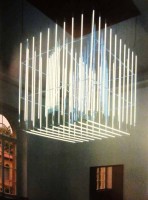LUCIO FONTANA
Light Cube
source: lucio-fontana
The Italian artist Lucio Fontana was born in Rosario di Santa Fé in Argentina as the son of Italian immigrants on February 19, 1899. His father is the sculptor Luigi Fontana. Lucio Fontana attends the Istituto Tecnico Carlo Cattaneo in Milan as of 1914. He serves in World War I in 1917, however, he is dismissed as early as in 1918, because of an injury, so that he can complete his engineering studies. He studies sculpting at the Accademia di Brera in Milan in 1920, but soon follows his family back to Argentina in 1922, where he works in his father’s sculpting studio. He has his own studio in Rosario di Santa Fé as of 1924. In 1928 he goes to Milan again and studies at the Accademia di Brera.
Besides figurative sculptures, he also makes terracotta reliefs and painted gypsum plates as of around 1930. In 1934 he and Fausto Melotti, Atanasio Soldati, Mauro Reggiani join the Paris artists group “Abstraction-Création”. They set up a manifesto on abstract art in 1935, Fontana’s first one-man show with abstract works takes place the same year in the Milan Galleria del Milione.
Lucio Fontana lives again in Argentina as of 1939, where he founds the private academy Altamira in 1947, he and his students at the academy compose the “Manifiesto Blanco” (white manifesto), demanding the synthesis of artistic genres and the renunciation of traditional materials. Back in Milan in 1947, he founds the “Movimento spaziale” and writes the “Primo Manifesto dello Spazialismo”, demanding a new form of space-oriented art. Two years later he realizes the projects “Ambiente nero” and the first “Ambiente spaziale” in the Galleria del Naviglione: objects painted with fluorescent colors in a darkened room are illuminated by an ultraviolet light. He composes the second manifesto of the Spazialismo the same year, followed by the third in 1950 and the fourth in 1951.
He executes the first perforated canvasses in 1949, they all carry the title “Concetto spaziale” (Space Concept). Lucio Fontana pierces the canvas, thus opening the image area, entirely doing without the conventional illusionist means of composition.
The series of the “Pietre” is made in the 1950s, stones and canvasses beset with pieces of color glass that make for elevation that extend the image space into real space.
In 1958 Lucio Fontana begins to slash monochrome painted canvasses. As of 1960 he combines the holes and slits with pastose color areas mixed with sand into which he makes scratches. At a later point he makes bronze objects, the “Nature”, with gaping gashes and dents. The series of works called “La fine di Dio” is made as of 1963.
.
.
.
.
.
.
.
source: tateorguk
Lucio Fontana 1899-1968
Italian painter, sculptor and ceramist, the founder of the Spazialismo movement. Born in Rosario de Santa Fé, in the Argentine, son of the Milanese sculptor Luigi Fontana and an Argentinian mother. Lived in Italy 1905-22, then again in Rosario de Santa Fé, where he opened a sculpture studio.
Returned to Italy in 1928, settling in Milan and studying sculpture at the Brera Academy 1928-30. First one-man exhibition at the Galleria del Milione, Milan, 1930. Began to make abstract sculptures and ceramics and became with Licini, Melotti and others a leading figure in the Italian abstract movement. Joined the group Abstraction-Création 1935. Spent 1939-47 in the Argentine, working part of the time in a figurative style, but in 1946 helped to found the avant-garde Altainira Academy at Buenos Aires, his ideas about the need for new art to express the modern world as revealed by science leading to the publication of the Manifiesto Blanco. Returned to Milan in 1947 and shortly afterwards issued the first Manifesto Spaziale.
The Spazialismo movement founded by him was joined by Capogrossi, Crippa, Dova, Peverelli and other young artists. Made abstract paintings with Baroque arabesques of punched holes or fragments of coloured glass, and later with vertical cuts; spent the summers at Albisola Marina making ceramics. Carried out various decorative projects for buildings, including ceilings using neon. Died at Comabbio (Varese), shortly after moving there from Milan.


